Microstructural characterization of silicon carbide reinforced dissimilar grade aluminium explosive clads
2020-06-28SaravananInokawaTomoshigeRaghukanan
S. Saravanan , H. Inokawa , R. Tomoshige , K. Raghukanan
a Research Centre for Advances in Impact Engineering, Sojo University, Kumamoto, Japan
b Department of Mechanical Engineering, Annamalai University, Tamilnadu, India
c Department of Nanoscience, Sojo University, Kumamoto, Japan
d Department of Manufacturing Engineering, Annamalai University, Tamilnadu, India
Keywords:Explosive cladding Aluminium Silicon carbide Microstructure Elemental mapping Hardness
ABSTRACT Aluminium composites are inevitable in ship building, commercial and defence aircrafts construction due to their light weight,high strength to weight ratio,admirable properties and cost affordability.In this study, the microstructural characteristics of explosive cladded dissimilar grade aluminium (Al 1100-A1 5052)clad composites reinforced with silicon carbide(SiC)particles is presented.Microstructure taken at the interface by optical and scanning electron microscopes (SEM) revealed the formation of a silicon carbide layer between the dissimilar grade aluminium sheets.Though reaction layers were witnessed at few locations along the interface, the diffusion of atoms between the participant metals is not visible as confirmed by energy dispersive spectroscopy, elemental mapping, line analysis and X-ray diffraction(XRD). The variation in microhardness at various regions of the silicon carbide reinforced dissimilar aluminium explosive clad is reported. The increase in tensile strength of the SiC laced clad is also presented.
1. Introduction
Researchers, worldwide, focus their attention in developing novel materials having light weight, good mechanical and corrosion properties at economical means. For the above needs,aluminium and its alloy are the principle choice [1]. Among aluminium alloys aluminium 1100 and aluminium 5052 show excellent potential in challenging applications namely automobile components, defence and commercial aircraft manufacturing [2].Welding of Al 1100-Al 5052 sheets are employed in fabrication of air craft and marine structures [1]. Joining of aluminium alloys by diffusion bonding and gas infiltration, though possible, consumes longer duration and generate higher temperature which promotes the formation of intermetallic compounds. These compounds, in turn, erode the mechanical strength of the joint [3]. Alternatively,explosive cladding offers a reliable solution to clad dissimilar grade aluminium alloys in a shorter duration and minimal increase of temperature.
Over the years, various researchers attempted explosive cladding of aluminium and its alloys with other metals. A few of the salient contributions are summarized here. In an earlier study,Grignon et al. tailored the experimental conditions by welding window and numerical simulation to attain a wavy interface in Al 6061 explosive cladding [4]. Meanwhile, Loureiro et al. reported enhancement in mechanical strength while cladding aluminiumcopper [5]. Fronczek and his co-workers reported the formation of TiAl and TiAl3phases in post annealed aluminium-titanium explosive cladding [6]. In another study, the same research group while analyzing the residual stresses generated in aluminiumtitanium explosive clads, observed the conjugate twinning grains[7]. Similarly, the formation of adiabatic shear bands and recrystallized grains in aluminium-magnesium cladding was reported by Zhang et al. [8]. Recently, Zeng et al. reported superior qualities of aluminium-magnesium clad composite produced in a helium environment [9]. In a different study, Hanliang et al. successfully cladded aluminium sheet with a metallic glass [10]. Alternatively,Han et al. inserted an aluminium interlayer between aluminium and steel plates and reported enhanced microstructural and shear properties [11]. However, Saravanan et al. employed different metallic interlayer between aluminium and copper plates and highlighted the significance of higher density interlayer [12].Interestingly, Gulenc et al. employed a stainless steel wire mesh between aluminium plates and reported enhancement in mechanical strength[13].Though attempts on conventional explosive cladding of aluminium with similar/dissimilar metals and introduction of interlayer were attempted by earlier researchers,studies on the variation in microstructure of silicon carbide particles reinforced dissimilar aluminium sheets processed through explosive cladding is scarce.Therefore,an attempt is made to explosively clad dissimilar grade aluminium sheets(Al 1100 and Al 5052)with silicon carbide particles dispersed between them. The microstructural characteristics are analyzed with the aid of optical microscope, scanning electron microscope, elemental mapping, line analysis and XRD.In addition,tensile strength and the variation in microhardness at various regions of the silicon carbide reinforced dissimilar aluminium explosive clad is reported.
2. Experimental
Silicon carbide particles,having an average size of 100 μm,were uniformly dispersed (0.2 mm thick) all over the mating surface of the Al 5052 base plate, having dimensions 60×80×5 mm3. Al 1100 sheets were positioned 5 mm above the base plate (standoff distance)of similar dimensions having thickness 2 mm(flyer plate)as shown in Fig.1.
The chemical composition of the flyer and base plates are given in Table 1. A chemical explosive having a detonation velocity of 4000 m/s and density 1.2 g/cm3was spread above the cardboard buffer plate (2 mm thick) and was detonated by an electrical detonator positioned at one corner of the experimental setup.Loading ratio, R (mass of the explosive/mass of flyer plate) of 0.7 was maintained for a parallel configuration explosive cladding experiments.The experimental conditions were chosen based on trial experiments. The detailed experimental conditions are presented elsewhere[14].
After obtaining the clads, the specimens were sectioned in the mid-region and were initially polished with different grades of emery sheets varying from #600 to #1500 sieve sizes. Subsequently, the samples for the microstructural observations were subjected to polishing in a polisher having alumina and colloidal silica suspensions, for 0.04 μm finish. The as-polished specimens were examined with NIKON-Opiphot optical microscope and Elionix ERA-600 Scanning Electron Microscope(SEM),equipped with AMETEK-EDAX analysis. The interface was analyzed by a Philips X’PERT MPD diffractometer (XRD), to determine the formation of reaction compounds if any. In addition, the Vickers hardness variation in various regions of the interface (average of 2 measurements)was determined by applying 25 g of load,with a dwell time of 15 s,in a Mitsutoyo MVK-HVL hardness tester. Ram tensile test, as per MIL-J-24445A standard, was performed in a UNITEK-94100 universal testing machine, and the results are reported.The fractured tensile sample was analyzed under a JEOL JSM-6610LV Scanning Electron Microscope, to determine the nature of fracture.
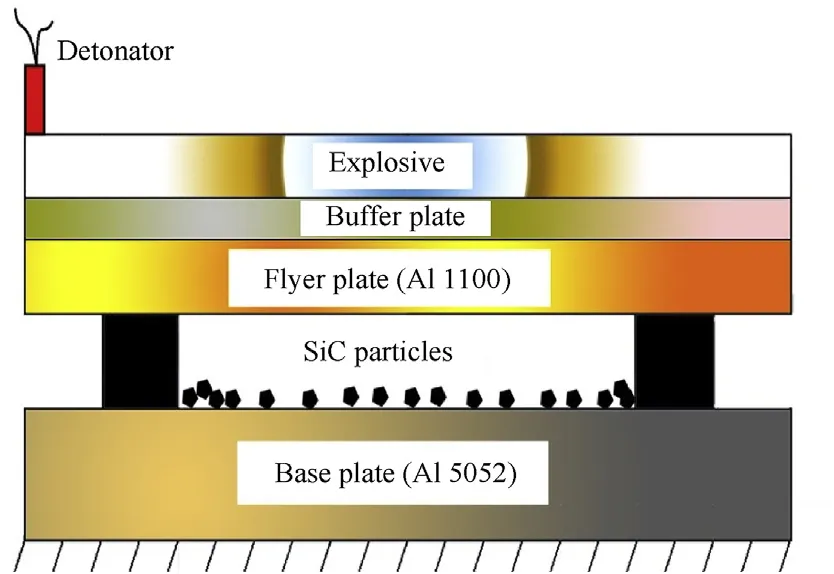
Fig.1. Explosive cladding with silicon carbide particles.

Table 1 Chemical composition of participant metal sheets.
3. Results and discussion
3.1. Microstructural observations
The interfacial micrographs (Fig. 2) reveal smooth wavy interface with silicon carbide particles spread in the middle(visible as a black patch). The impact of two sheets, with interspersed SiC particles introduces a thin streak of SiC at the interface. Formation of wavy interfaces in explosive clads is consistent with the earlier literatures [15-18]. The interfaces were free from defects such as cracks,trapping of jet and solidified melt.The SiC particles,spread at the mating faces of the sheets,appear to form a thin band at the interfaces upon collision of sheets. The thin streak traces the contour of the undulations, though its thickness varies. At few locations, the streak is extremely thin to the point that it gets disconnected. The streak, thus, is not continuous but intermittent.At other locations,the streak was thick due to the conglomerations of the particles which is influenced by the collision pressure and the temperature rise. In the vortex region, the SiC particle’s conglomeration duplicated the molten layers.
The optical micrographs at various locations of the clad reveal a wavy topography, due to rapid collision of flyer plate. The higher collision velocity promotes an increase of pressure near the collision point which exceeds the yield strength of the base metal by a significant margin [7,16]. The pressure (P) developed at the interface is estimated by Ref. [19].

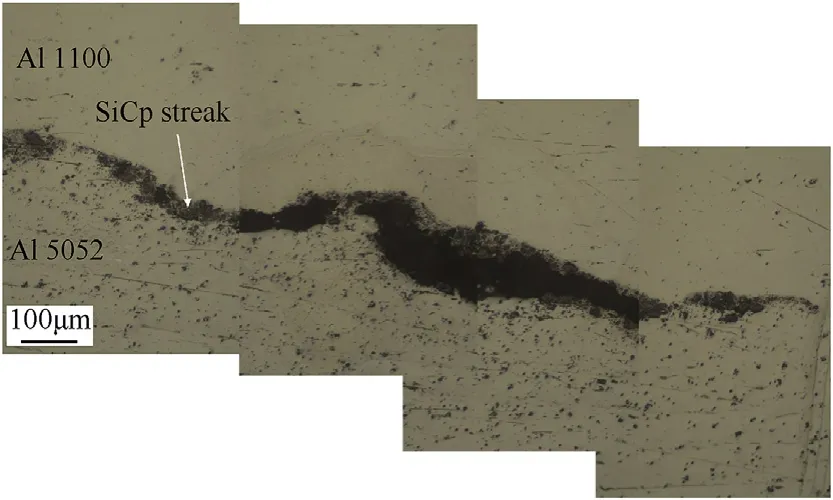
Fig. 2. Microstructure at the mid region of the explosive clad (Al 1100-SiC-Al 5052).
where ‘ρ’ is the density of flyer plate and ‘Vp’ is the velocity of the flyer plate,dictated by the detonation velocity(Vd)of the chemical explosive and dynamic bend angle [15]. Subsequent to the developed pressure, the rate of deformation in the closer proximity of the collision point is enormous leading to the formation of plastic surface,and thereby a wavy topography.This is consistent with the reports of Song et al. [20]. The higher thermal conductivity of aluminium(250 W/mK)promotes a plastic interface as well.As the mating surfaces turn molten, the unescaped silicon carbide particles, entrapped in the middle, were compressed and establish a good mechanical bonding (Fig. 2) with the participant metals. The amount of silicon carbide particles is maximum at the mid region of the clad,as the particles in both ends were ejected during the high impact collision. In addition, the initial uniform dispersion of SiC particles is violently disturbed during jetting and which cause conglomeration of the SiC particles in the mid-region, as seen in Fig. 2.
In an earlier study, Arsenault proposed three possible hypotheses for the adhesion of aluminium with silicon carbide particles as(a)existence of a thin silica layer at the aluminium-silicon carbide interface (b) absence of chemical bonding and (c) probable formation of an A14C3between aluminium and silicon carbide [21].According to Reddy et al. formation of Al4C3is detrimental to the mechanical properties of the aluminium-silicon carbide composites[22].However,in this study,the existence of SiC is witnessed as a thin layer at the interface along with and the absence of chemical bonding as reported by Arsenault[21].In addition,the formation of reaction compounds (Al4C3) or solidified melts were not observed at the interface. In order to confirm the presence of reaction compounds if any, the clad interface is subjected to analysis under a higher magnification SEM, elemental mapping and XRD, which provides further insight, as detailed in the next section.
3.2. Scanning electron microscopy and XRD
The lower magnification of the dissimilar aluminium clad interface (Fig. 3a) exhibits the characteristic undulations at the interface and the presence of a continuous thin streak of SiC particles of reduced size.However,at higher magnification(Fig.3b)the continuous streak of silicon carbide particles appears to be intermittent and discontinuous at few locations with the formation of local melt pockets around the silicon carbide particles. It is speculated that the local melt pockets were formed due to the excessive melting of aluminium from the thermal energy produced during the collision imparted and the kinetic energy dissipated at the interface [16]. The presence of melt pockets produces a negative effect on the metallurgical and mechanical properties of clad [23].
The EDS analysis performed at 100 μm distance away from the interface revealed the absence of intermetallic compounds.Further,the regions in the closer proximity of the interface (melt pockets)are subjected to EDS analysis (Fig. 4) to determine the nature of reaction, if any, between aluminium and silicon carbide. The EDS analysis at regions 1, 2 and 4 showed the higher concentration of aluminium and traces of other elements Si, C, O and Mg. The selected regions were free from the formation of detrimental reaction compounds.Similarly,EDS analysis performed on the region 3, comprising of both aluminium and silicon carbide, show the larger peaks of aluminium and silicon in their respective regions.From the EDS analysis it was confirmed that the diffusion of silicon atoms inside the flyer or base plates did not occur. This concurs with the reports of Bazarnik et al. [24] who concluded that the atomic diffusion between aluminium and silicon carbide does not occur.
The elemental mapping across the interface(Fig.5 a-d)revealed the visible absence of atomic diffusion between the two grades of aluminium sheets. The elemental distribution of aluminium and silicon at the interface is shown in Fig. 5a and b respectively. In addition, the overlay image of the distributions of aluminium, silicon, carbon and magnesium in the interface is shown in Fig. 5c.
The elemental mapping revealed the absence of atomic diffusion across the interface. Even in the closer proximity, it seemed that the formation of mechanical locking driven mass transfer across a very small region (<10 μm) took place. The typical quantitative line scan across the clad (Fig. 5d) revealed the presence of gradual transition in percentage element counts across the interface. In addition, the XRD analysis performed at the interface(Fig. 6), show the presence of aluminium and SiC atoms alone,confirming the absence of Al4C3. Hence it is concluded that a mechanical bonding,instead of chemical bonding,occurs in explosive cladding as reported by Oberg et al. [25].
3.3. Micro-hardness
Vickers micro-hardness of the pre clad Al 1100 and Al 5052 were 47 Hv and 74 Hv respectively. After cladding, the hardness of Al 1100 increased by 16%, while there was no significant increase on the Al 5052 side as reported by earlier researchers [26,27]. The hardness of the silicon carbide also increases from 52 Hv to 63 Hv(Fig. 7).
The increase in hardness near the interface is due to impulse shock received by the participant metals and the high speed collision.The gradual decrease in hardness away from the interface was witnessed following subsequent reduction in plastic deformation of colliding sheets.
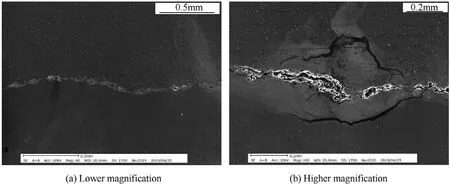
Fig. 3. SEM observations of the explosive clad (Al 1100-SiC-Al 5052).
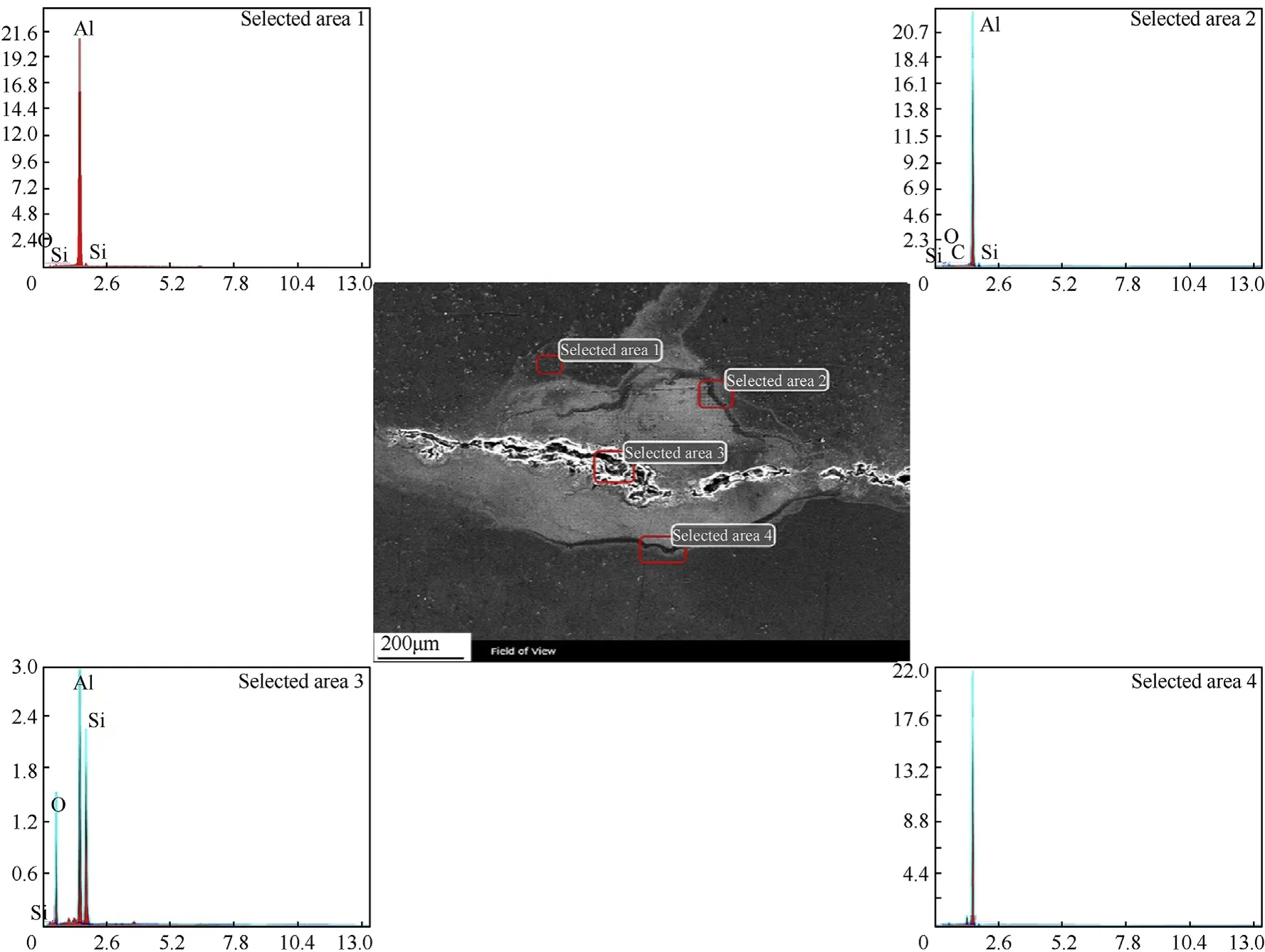
Fig. 4. EDS analysis of the explosive clad (Al 1100-SiC-Al 5052).
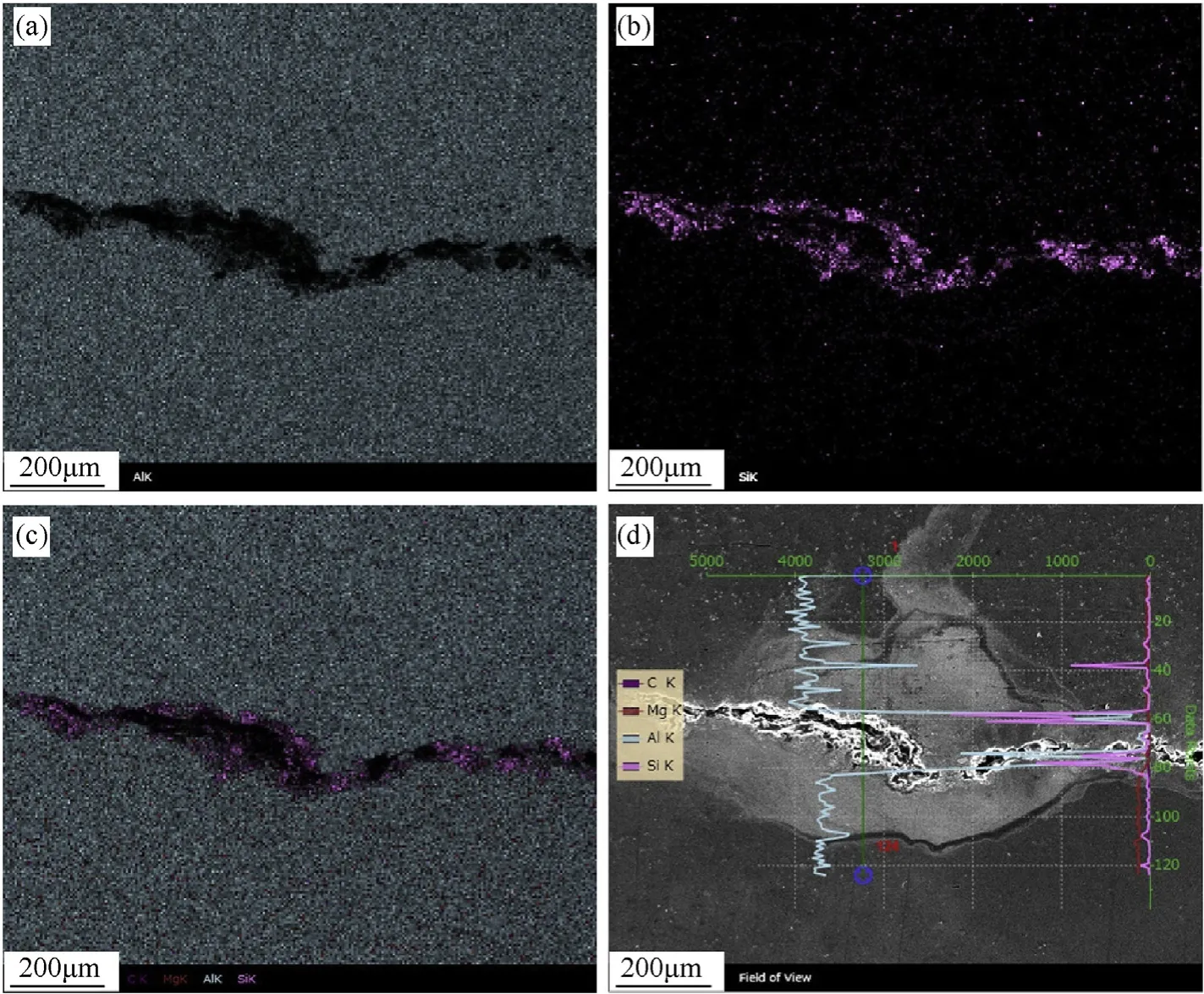
Fig. 5. Elemental mapping across the interface on (a) aluminium atoms (b) silicon atoms (c) overlay image of C, Al, Mg and Si atoms and (d) line scan at the interface.
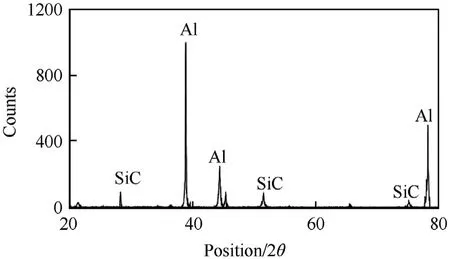
Fig. 6. XRD analysis performed at the interface.
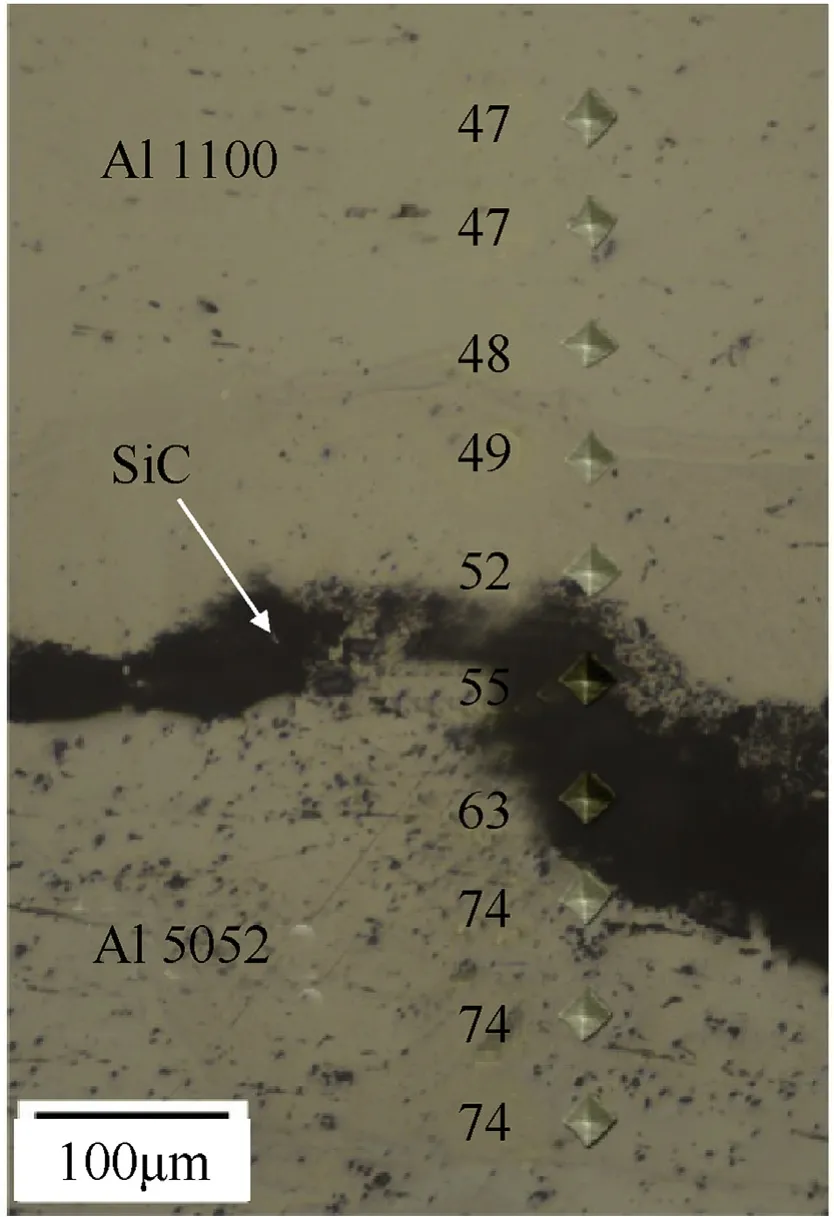
Fig. 7. Hardness variation across the explosive clad (Al 1100-SiC-Al 5052).
3.4. Tensile strength
The tensile strength of the dissimilar grade aluminium explosive clads laced with SiC particles exhibited a higher yield strength(81 MPa), tensile strength (148 MPa) and elongation (5.23%). The obtained tensile strength is 23% higher than the conventional clad(without SiC particles: 120 MPa) and the weaker parent metal (Al 1100:117 MPa).During tensile testing,all specimens were fractured at the weaker metal as reported by Kumar et al.[28].The increase in tensile strength is seen by the ductile fracture mode (Fig. 8). The fracture surface is free from cleavage or intergranular fracture characterizing the brittle mode of fracture.
4. Conclusion
The microstructural study on the explosive cladding of dissimilar grade aluminium plates reinforced with silicon carbide particles led to the following salient conclusions.

Fig. 8. Fractograph of the fractured specimen.
1. Silicon carbide particles form a continuous layer at the interface and create a mechanical bonding between the colliding sheets.
2. The interface exhibited a characteristic undulating interface free from detrimental Al4C3compounds.
3. EDS and XRD analysis confirm the absence of intermetallic compounds across the interface.
4. Hardness value tends to increase at closer proximity to the interface.
5. Tensile strength of the SiC laced clad is higher than conventional clad and weaker base alloy.
Declaration of competing interest
The authors declare that they have no known competing financial interests or personal relationships that could have appeared to influence the work reported in this paper.
杂志排行
Defence Technology的其它文章
- Statistical variability and fragility assessment of ballistic perforation of steel plates for 7.62 mm AP ammunition
- Texture evaluation in AZ31/AZ31 multilayer and AZ31/AA5068 laminar composite during accumulative roll bonding
- Local blast wave interaction with tire structure
- Research and development of training pistols for laser shooting simulation system
- Summed volume region selection based three-dimensional automatic target recognition for airborne LIDAR
- A novel noise reduction technique for underwater acoustic signals based on complete ensemble empirical mode decomposition with adaptive noise, minimum mean square variance criterion and least mean square adaptive filter
